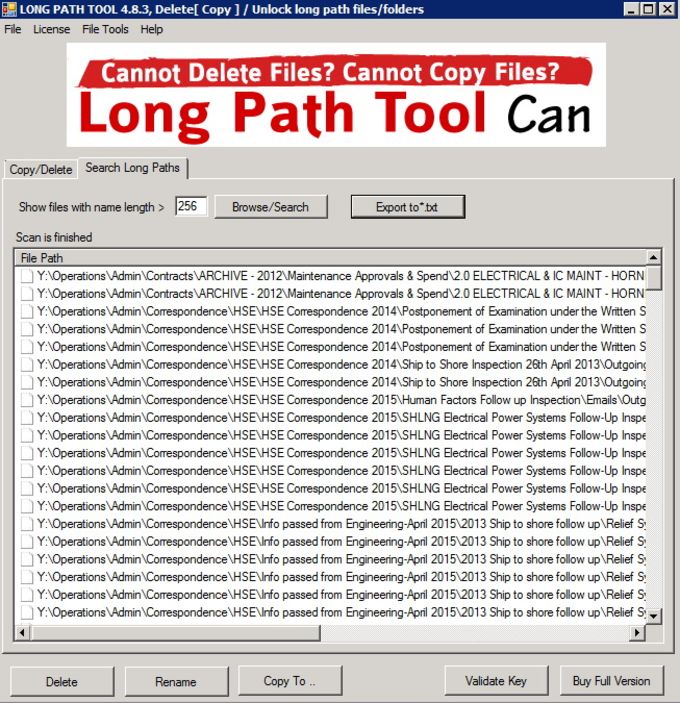

- #Long path tool full open source how to
- #Long path tool full open source software
- #Long path tool full open source code
- #Long path tool full open source windows
Warning message2Note IISService is an IIS service that is running on the computer. On a server that is running IIS 6.0 or higher, warning messages that resemble one of the following are written to the System log: For example, the progress bar moves very slowly when you try to view a Web page, or you notice a message that resembles the following in the status bar: You experience slow performance on a server that is running IIS. For example, the Web page appears to be blank or stops responding. When an IIS process like Inetinfo.exe, Dllhost.exe, or W3wp.exe stops responding (hangs), you may experience any of the following symptoms:Ī Web page does not load correctly.
#Long path tool full open source how to
This article describes how to use the Debug Diagnostics v1.2 tool to troubleshoot a Microsoft Internet Information Services (IIS) process that has stopped responding. You can create a share to a directory (if it's not the root) such that the shared directory becomes the root of a virtual drive which then allows up to 260 characters of path under normal use.How to use the Debug Diagnostics tool to troubleshoot a process that has stopped responding in IIS Summary One way long paths can get created unintentially is via shares.
#Long path tool full open source windows
Long paths can be created accidentally in Windows making them very hard to process. The only API that does not work as expected is Directory.SetCurrentDirectory as Windows does not support long paths for a current directory. To force reference to the Pri.LongPath types simply create aliases to them with the using directive: Referencing the entire Pri.LongPath namespace will cause conflicts with System.IO because you almost always need to reference something else in System.IO. So, you really only need to force reference to the LongPath types. The APIs provided have been made identical to the System.IO APIs as best I could (if not, please log an issue fork and provide a failing unit test or fork, fix, add passing test). It's usually easiest just to grant full control to your user on the root LongPath directory (and let it inherent to children). Note: the units test currently expect that the user running the tests has explicit rights (read/write/create) on the TestResults directory and all child directories. Resolving this conflict is easily solved through aliases (see below).
#Long path tool full open source code
I feft that not having to modify your code was the greater of the two evils. Obviously to replace only 6 types in a namespaces ( System.IO) and not the rest is problematic because you're going to need to use some of those other types ( FileNotFoundException, FileMode, etc.)-which means referencing System.IO and re-introducing the original 6 types back into your scope. You simply reference the Pri.LongPath types you need and you don't need to change your code. LongPaths allows your code to support long paths by providing a drop-in replacement for the following System.IO types: FileInfo, DirectoryInfo, FileSystemInfo, FileInfo, DirectoryInfo, FileSystemInfo.

(with one caveat: Directory.SetCurrentDirectory, Windows does not support long paths for a current directory). So, I drastically expanded the API scope to include FileInfo, DirectoryInfo, FileSystemInfo to get 100% API coverage supporting long paths. LongPath originally started as a fork of LongPaths on Codeplex but after initial usage it was clear that much more work was involved to better support long paths. You can likely support long paths with the above-mentioned libraries, but you end up having to scrub your code and re-design it to suit these new APIs (causing full re-tests, potential new errors, potential regressions, etc.).
#Long path tool full open source software
"When I use a path like c:\users\ 300 chars removed\Document.docx your software gives me an error". Usually after you've released something and someone logs bug (e.g. Often times long path support is an after thought. But, these libraries do not seem to support the entire original API ( Path, File, Directory) and not all file-related APSs (including FileInfo, DirectoryInfo, FileSystemInfo). NET in classes like LongPath LongPathFile and LongPathDirectory. Several attempts like (which a more up to date version has made its way into. This makes it hard to entirely support long paths in any application, let alone in. The file system (NTFS), for example, supports long paths quite well but other things like Command Prompt and Explorer don't. Unfortunately, other aspects of Windows haven't supported long paths in their entirely. Supporting files and directories with a long path is fairly easy with Windows. A drop-in library to support long paths in.


 0 kommentar(er)
0 kommentar(er)
